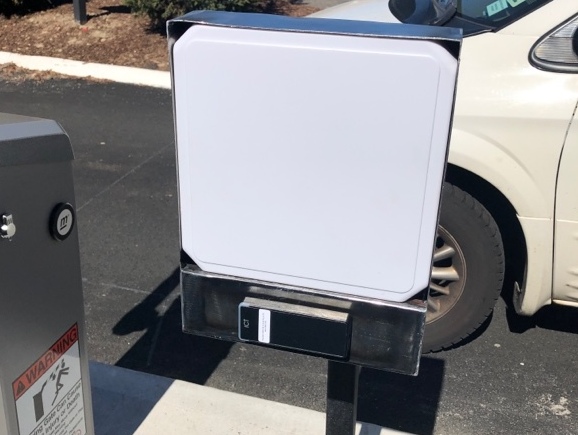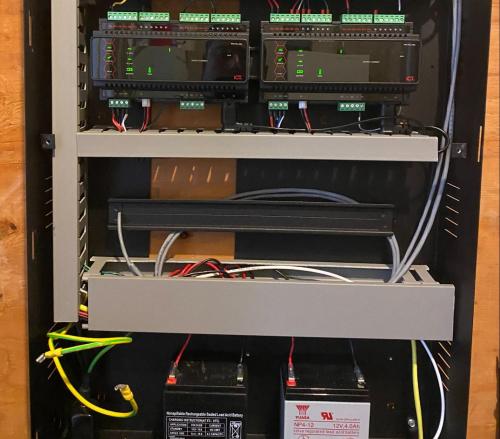Video MGMT System
 Access Control
Access Control
Voice & Data Wiring
 Burglar Alarm
Burglar Alarm
 Fire Alarm
Fire Alarm
Video MGMT System
Voice & Data Wiring
THOUGHT CENTER > Blog > Access Controls
September 9, 2023
Too busy to read? Here’s a summary:
If you're looking to ramp up your security posture, you've likely heard of access control systems. But what exactly goes into these systems? What are the key components and parts that make them tick?
In this guide, we'll explore the world of physical access control by examining its components and parts. By the end, you'll have a solid understanding of the components that any physical access control system is likely to have.
Before we dive into the nitty-gritty, let's get our basics straight: An access control system is a security system that regulates who can enter physical areas or access digital resources.
Data access control, also known as digital access control, is designed to secure digital information, but today, we’re focusing on the common components of physical access control systems. A physical access control system is designed to prevent unauthorized physical entry to controlled spaces.
In our review of the components that make up a physical access control system, let’s begin with credentials. They're the IDs that authorized users must bring with them to gain access to physical spaces.

Credentials have been compared to traditional keys because users must bring them to gain access, but they don’t mechanically unlock barriers. Instead, they contain identifying data that the access control system “reads” in order to verify identities.
Unlike traditional metal keys, access control credentials come in many forms, each with its own advantages, limitations, and ideal use cases.
Knowledge Credentials: Knowledge credentials are the most basic credential type. When required, a preprogrammed PIN or passcode must be entered on a touchscreen or keypad for entry.
While simple and cost-effective, knowledge credentials are the least secure option for ID verification because they can be guessed and are often shared.
Access Cards and Key Fobs: These are physical devices that contain microchips with identifying data and tiny antennas for communication with the access control system. When swiped or tapped against a reader, they transmit their data for verification, usually in the form of radio-frequency identification (RFID) or near-field communication (NFC) signals.
While convenient and more secure than knowledge credentials, cards and fobs pose a security threat when lost, stolen, or inadequately encrypted.
Mobile Credentials: With the widespread adoption of smartphones, mobile credentials are becoming increasingly practical. Mobile credentials store highly encrypted identifying data on a user's smartphone, which can then be transmitted to a compatible reader in the form of Bluetooth or near-field communication (NFC) signals, both of which are highly encrypted and nearly impossible to clone.
Biometric Credentials: As the most secure credential type, biometric credentials are often preferred for high-security environments. Biometric access control systems scan a user’s unique biological characteristics—such as a fingerprint or the pattern of a retina—for identification. There are two downsides to biometric access control systems: they often feel invasive, and they can slow down the entry process.
For enhanced security, many modern systems employ multi-factor authentication (MFA). This requires users to present two or more different types of authentic credentials for identification. For example, a user may need to swipe an access card and then input a PIN or scan a fingerprint. Given that most credentials can be lost or stolen, and sometimes even copied, multi-factor authentication is a smart option for maximizing entry security.
Access control readers are usually installed at access points (near barriers like doors and gates). They come in many forms to suit the wide range of credential types available for modern access control.
Once a reader collects and verifies identifying data from a credential, it will transmit the data to a control panel for further processing and final decision-making.
Keypad and Touchscreen Readers: Knowledge credentials, such as PINs and passwords, must be entered on readers featuring keypads or touchscreens.
Card Readers: Card readers capture identifying data in the form of electronic signals transmitted by cards and fobs.
Mobile Readers: Mobile credential readers are able to collect identifying data that is transmitted by smartphones with Bluetooth or NFC features enabled.
Biometric Readers: Biometric readers assess an individual’s unique physiological features to identify them. Biometric readers may include fingerprint scanners, retina (or iris) scanners, and even security cameras with facial recognition software.
Combination Readers: Because many access control protocols require multi-factor authentication for the highest level of security, most access control door readers are designed to collect data from multiple forms of identification. For example, a reader may feature a keypad or touchscreen, as well as multiple internal antennas capable of collecting data from different types of electronic signals, such as Bluetooth and RFID.
Any discussion of access control system components would be incomplete without mentioning locks and barriers—the parts that physically prevent unauthorized entry.
Locks in an access control system are not your average mechanical padlocks or deadbolts. Access control locks are instead controlled electronically by the system control panel.
The control panel will transmit an electronic unlock signal to a door lock only if it finds a match between a presented credential (or credentials) and the preset access authorization rules at the entry where it has been presented.
Doors and other barriers force users to wait for access approval. Without physical barriers like gates, solid doors, and automatic doors, an access control system’s entry threshold would be defenseless.
An access control system’s control panel is far more than a simple computer. It’s both the brain and the central nervous system of your entire access control setup. It’s responsible for orchestrating the symphony of components that work in harmony to keep your premises secure.

The control panel receives a constant stream of data from sensors, door readers, and other input devices scattered throughout access points.
But it doesn't just passively receive this information; it actively processes it by using preprogrammed lists, rules, and algorithms to evaluate credential data and make real-time decisions. These decisions can range from straightforward tasks, such as transmitting unlock signals for authorized users, to more complex actions, such as triggering alarms when multiple failed access attempts are detected in succession.
Access control panels usually come with intuitive interfaces that allow administrators to easily configure settings, add or remove access permissions, and generate reports for auditing purposes. Most control panels even integrate with mobile and desktop apps so that they can be remotely monitored and controlled.
The Importance of Credential Management
Managing credentials is critical to access control security. Credential management involves not only the issuance of credentials but also their revocation when they are lost, stolen, or when an employee leaves an organization.
When discussing access control system components and parts, it's easy to overlook the critical infrastructure that allows all the different parts of an access control system to communicate with each other: structured cabling.
Structured cabling refers to standardized cabling architecture for data transmission that is labeled and well-organized for future adjustment and scaling needs.
A door closer is a mechanical device that closes a door after it has been manually opened, ensuring that the door remains closed unless intentionally opened.
Door contact sensors detect when a door is opened or closed and send this information back to the control panel. These sensors can be configured to send alerts if a door remains open for an extended period, helping to prevent doors from being propped open.
Push-to-exit buttons are devices installed near access control exit points that, when pressed, unlock doors to allow exit. These buttons provide a quick and easy method for individuals to exit a secured area without compromising the security of entry points. These buttons are particularly useful during emergency situations.
Emergency exit hardware refers to devices like panic bars and crash bars installed on exit doors. This hardware ensures that, even in high-security environments without push-to-exit buttons, individuals can quickly and easily exit in the event of an emergency without needing to stop and present access credentials.
For a reliable access control system that meets your site’s unique security and logistical challenges, consult Mammoth Security's experienced access control experts. We partner with the world’s top access control brands and can explain the different features and technologies available.
Contact us today to schedule a free security consultation with a friendly expert from our team. We’ll perform a 100% free site survey and help you make informed decisions about the ideal security posture for your organization’s physical layout, workflows, and security needs.
NOT COMPLETELY SURE?
860-748-4292The core components of a physical access control system include credentials, access control readers, locks, doors, and a control panel. These elements work together to regulate who can enter specific physical spaces.
In an access control system, credentials serve as digital IDs that authorized users must present to gain entry. These can range from knowledge credentials like PINs to biometric credentials like fingerprints.
In access control, multi-factor authentication (MFA) is a security measure that requires users to present two or more types of credentials for identification. This enhances the overall security of the entry protocol.
Structured cabling is crucial in access control systems because it serves as the backbone for data transmission between the different parts and components of the system. Low-voltage structured cabling ensures that all parts of the system can communicate with each other effectively.
In access control systems, the types of locks used are generally electromagnetic locks, electric-strike locks, and smart locks. These locks are usually controlled electronically by the system's control panel.
Biometric credentials enhance access control security by providing unique biological characteristics, such as fingerprints and iris patterns, for identification. This makes it extremely difficult for unauthorized users to gain access.
The control panel in an access control system acts as the brain of the system. It processes data from sensors and readers, making real-time decisions to grant or deny access.
In modern access control systems, mobile credentials store encrypted identifying data on a user's smartphone. This data can be transmitted to a compatible reader via Bluetooth or near-field communication (NFC) signals.
In the context of access control, door contact sensors detect when a door is opened or closed. They send this information back to the control panel and can trigger alerts for extended door-open periods.
Credential management is critical in access control security because it involves the issuance and revocation of credentials and their associated privileges. Proper management ensures that lost or stolen credentials are deactivated, maintaining the integrity of the system.